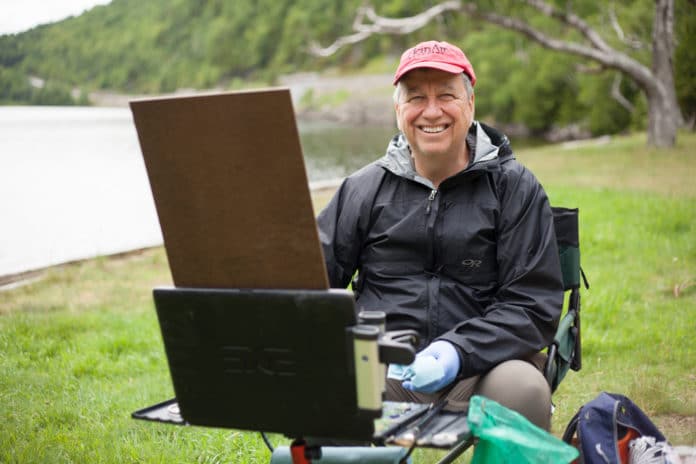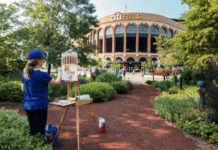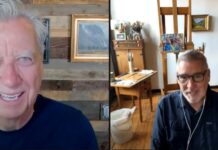Looking as far back as the 16th century, we find plein air artists who were masters of painting techniques, storytelling, and visual poetry. Their paintings continue to inform and inspire us, as do those by contemporary artists who preserve the tradition in workshops, festivals, and studios.
All of us, as artists, are on a path to develop and grow. Doing it on our own, being self-taught, is for some a badge of courage. Yet I’ve discovered that no matter how much I discover on my own, there are others who have figured things out that I would never think to explore.
That is why mentors are so important, and it’s why many of the great painters of the past continually sought new ideas and techniques from other artists. In fact, my biggest leaps as a painter come from studying masterpieces from the past and from spending time with other contemporary artists who understand something I hadn’t worked out on my own.
As plein air artists, we can access a pantheon of great European and American artists. Quickly reviewing the history of painting directly from nature, we find Peter Paul Rubens (1577–1640) creating oil sketches of landscapes (although we can’t be certain he painted on location). It is believed that Italian artist Agostino Tassi (1578–1644) taught artist Claude Lorrain (1604–1682) to paint on location, although Claude is known to many as the father of outdoor painting.
Drawings of an early outdoor paint box used to paint paysages (landscapes) appear in a diary by royalist soldier Richard Symonds (1617–1660), who suggested they were being used by painters Nicolas Poussin (1594–1665) and Giovanni Angelo Canini (1617–1666). Italian artist Salvator Rosa (1615–1673) and Poussin also painted on location with Claude, the latter having documented outdoor painting done by the German-born Joachim von Sandrart (1606–1688).*
I’ve concluded that the process of painting needs to become second nature before one can find one’s own voice. It’s really true in all things; it’s difficult to type when you have to look at the keyboard, and it’s hard to play the piano or the guitar when you have to think about the keys or the strings. When we don’t have to think about the execution is when our voices are first freed up to make their own mark.
First, we need to master technique to the point that we can paint proficiently without thinking about it, and at the highest level of quality.
Once we get to second nature, many of us begin experimenting, taking away some of the comfort of the “second nature zone.” For instance, each time I experiment by adding a new color to my palette, I have to relearn color mixing to understand the impact of that single color.
That’s why so many of the best painters always lay their colors out in the same places and the same order, and avoid adding new colors. Imagine adding a new note in the middle of a piano keyboard — second nature would suddenly be broken.
But where does technique end and painting begin? For me, most of my painting life has been focused on perfecting my craft, getting to the point that I can create anything I see with close to perfect values and colors. After two decades, I am only now getting close to doing that by second nature, but that is a result of having little time to paint.
Yet is being able to reproduce what you see enough? Our world is filled with great technicians and draftsmen who can lay down what they see in a technically perfect painting. But what separates the men from the boys and the women from the girls is something that goes beyond mere technique.
It’s the ability to resist painting what you see and instead lay down colors, tones, and shapes you don’t see that makes painting an emotional experience. It’s the ability to shift objects to perfect composition, drawing the viewer into a deeper story. It’s the ability to create not just a painting, but a world-class work of art that opens hearts and lays bare one’s raw emotions to the viewer.
The poets of the past give us something to strive for. Sargent, Zorn, Sorolla, Fechin, Levitan, Shiskin, and other greats went beyond technique. Their paintings told us stories, created emotional responses. They were storytellers and poets.
Although painting is about so many things, it’s the challenge, the growth, the push for the next level to get better that keep me interested. And we as painters should always be rising to that challenge, not becoming satisfied with our level of achievement, but seeing how high we can go.
I’m thrilled to be part of this massive outdoor painting movement and to see so many people learning and growing, each at a different stage, each pushing for the next. I consider it my personal responsibility to provide you with inspiration, education, and engagement, to help you take your own painting as far as you can take it by offering stories, techniques, training videos, competitions, and events like the Plein Air Convention. Because those who are never satisfied with the status quo are the ones who become the great storytellers and poets.
*Historical source: Mark Evans, “John Constable: Oil Sketches from the Victoria and Albert Museum”





Great article Eric! Having painted and taught for over 50 years I think that one needs to not just first master ones craft..but to be encouraged all along to consider your own voice and unique concepts that we all have inside of us. I have found that it is all very time consuming and I think one needs to be having that attitude of looking for our uniqueness of seeing the world through our own point of view. I am just concerned that people may get the idea that they need to hone their skills of drawing, color and such before they go beyond all of that. I was trained as an Illustrator and our job was already to tell a story..although, usually someone else’s story..but that became a challenge and at least got one thinking in that direction. Even with that advantage most of us Illustrators still found we needed to make some changes in moving into the Fine Arts. I still struggle as I think most of us do with trying new things, medium and getting out of my own comfort zone…and the reality is that we probably fail more than we succeed, but one needs to have that attitude and i really think it should also be encouraged at the start..most contemporary or modern art emphasizes that approach. I remember a new Art School Director being interviewed and saying that “We don’t teach skills here so much..as it gets in the way of “Creativity”! Well…having worked for over 40 years at honing my “skills”, I was at first insulted and then started to think..that he did have a point…too much emphasis on skills, does get in the way of creativity and I was a pretty good example at the time! Anyways..I have been spending the last two months, trying some new concepts, styles and such, so was really interested in your article. Most of us probably do work hard on our skills, but I think we need to also hone the “skill” of having our own voice..which for many may be the hardest of all! Thanks again for inspiring us one way or the other!!